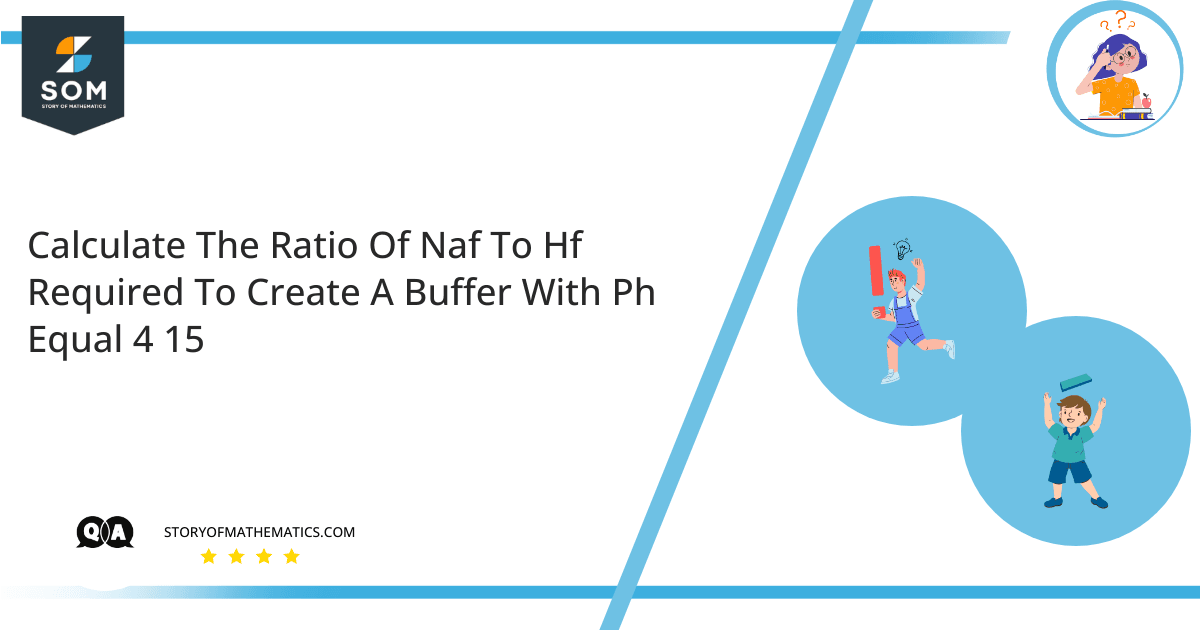JUMP TO TOPIC

The main objective of this question is to calculate the ratio $NaF$ to $HF$ required to create a buffer with a given $pH$.
A buffer is an aqueous solution that sustains noticeable variation in $pH$ levels when a small amount of acid or alkali is added, which is made up of a weak acid and its conjugate base, or vice versa. When the solutions are mixed with a strong acid or base, a rapid change in $pH$ can be observed. A buffer solution then facilitates neutralizing some of the added acid or base, allowing the $pH$ to change more progressively.
Each buffer has a fixed capacity, which is defined as the amount of strong acid or base required to change the $pH$ of $1$ liter of the solution by $1$ $pH$ unit. Alternatively, buffer capacity is the amount of acid or base that can be added before the $pH$ significantly changes.
Buffer solutions can neutralize up to a certain limit. Once the buffer has reached its capacity, the solution will behave as if there is no buffer present, and the $pH$ will begin to fluctuate substantially again. The Henderson-Hasselbalch equation is used to estimate the $pH$ of a buffer.
Expert Answer
Now, using the Henderson-Hasselbalch equation:
$pH=pK_a+\log\dfrac{[F]}{[HF]}$
$pH=pK_a+\log\dfrac{[NaF]}{[HF]}$
$pH-pK_a=\log\dfrac{[NaF]}{[HF]}$
$\log (10^{(pH-pK_a)})=\log\dfrac{[NaF]}{[HF]}$
Applying anti-log on both sides, we get:
$10^{(pH-pK_a)}=\dfrac{[NaF]}{[HF]}$
Since $pK_a=-\log K_a$, so:
$\dfrac{[NaF]}{[HF]}=10^{pH-(-\log K_a)}$
$\dfrac{[NaF]}{[HF]}=10^{pH+\log K_a}$
$\dfrac{[NaF]}{[HF]}=10^{4.00+\log (3.5\times 10^{-4})}$
$\dfrac{[NaF]}{[HF]}=3.5$
Example 1
Suppose that there is a solution of $3M$ $HCN$. Find the concentration of $NaCN$ needed in order for $pH$ to be $8.3$, provided that the $K_a$ for $HCN$ is $4.5\times 10^{-9}$.
Solution
Using the Henderson-Hasselbalch equation, we get:
$pH=pK_a+\log\dfrac{[CN^-]}{[HCN]}$
$8.3=pK_a+\log\dfrac{[CN^-]}{[HCN]}$
Since, $K_a$ of $HCN$ is $4.5\times 10^{-9}$, so $pK_a$ of $HCN$ will be
$pK_a=-\log( 4.5\times 10^{-9})=8.3$
So, we will have the above equation as:
$8.3=8.3+\log\dfrac{[CN^-]}{[HCN]}$
or $\log\dfrac{[CN^-]}{[HCN]}=0$
It is given that $HCN=3M$, therefore:
$\log\dfrac{[CN^-]}{[3]}=0$
$\dfrac{[CN^-]}{[3]}=1$
$[CN^-]=3M$
Consequently, a concentration of $3M$ $NaCN$ allows the $pH$ of the solution to be $8.3$.
Example 2
Find the ratio of conjugate base to acid, if the solution of acetic acid has a $pH$ of $7.65$ and $pK_a=4.65$.
Solution
Since, $pH=pK_a+\log\dfrac{[A^-]}{[HA]}$
Substituting the given data:
$7.65=4.65+\log\dfrac{[A^-]}{[HA]}$
$\log\dfrac{[A^-]}{[HA]}=3$
$\dfrac{[A^-]}{[HA]}=10^3=1000$
